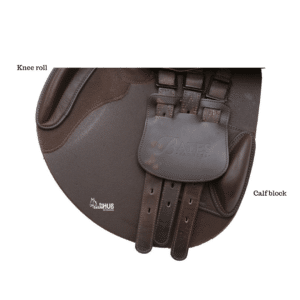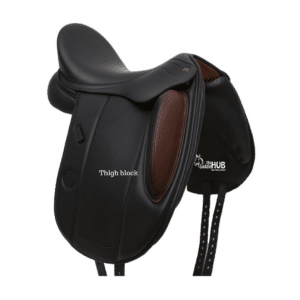We love to make sure you have the right saddle, the perfect fit for you and your horse. We also love to bring you information so you can understand and make the best decisions. Though each saddle is different, the terminology in design is generally across the board and knowing what’s what, and what’s where, can make a big difference to your next purchase.
Saddle Terminology
Key Parts of The Saddle

Rise: The part of the seat in front of your pubic bone.
Twist: The part of the seat between your legs, these can vary in widths.
Cantle: The highest part of the seat, below/behind your lower back.

Knee Roll: Depending on the saddle this can run the length of the front of the sweat flap.
Knee Block: On the top of the sweat flap just above the knee; generally triangular shape.
Calf Block: On the rear of the sweat flap on some cc and ap saddles.

Front Block: On dressage saddles, on the front of the sweat flap; often runs the entire length of the front of the sweat flap.

Point Billet: The billet attaches to the point of the saddle tree; it may emerge through the rear or the end of the thigh block.
Swing or Sliding Rear Billet: A “self adjusting” rear billet attached via a ring to a nylon strap; the nylon strap is attached at the middle and rear of the saddle tree, creating a “V”.

Gullet: The area under the head (front, pommel) of the saddle.

Channel: The space between the panels.
Additional Terminology
Mono-flap: Saddle with one single flap, the knee/thigh/calf blocks can be external or on a modified sweat flap.
Flap strap: The strap on the bottom of the flap, can either buckle to the girth or to itself. Common on older models of dressage saddles, now rarely seen.
Overlay billets: External billets that lie on top of a monoflap saddle’s flap.
Flocked panel: Wool (or synthetic fiber) is ‘stuffed’ into the panel. These panels are usually the softest of the panels and break in quickly. They can be adjusted by adding, shifting, or removing wool. There will usually be flocking “slits” through which the flocking is adjusted, under the flap.
Swiss panel: Wool flocking encased in felt. These panels can be adjusted by flocking, though not to the degree a plain flocked panel can.
French panel: Foam encased in felt. Can only be adjusted with pads and shims.
Foam panel: Plain foam. Like the French panel, these can only be adjusted with pads and shims.
Wither/front gussets: Gussets in the front of the panel, in the wither area. Fitting option used for a horse that has dips below the wither, or is narrower in front. (Full front gussets are extended wither gussets that are useful for a horse that needs more support in front if downhill, narrower in front or with a wither.
Dropped / trapezius panel: The panels are deeper in the area below and to the rear of the wither. Fitting option used, (often in conjunction with wither gussets), for a horse with dips behind and to the rear of the wither.
K” panel: Panel is deeper under the front half of the saddle. Fitting option used for a horse with a high, “shark fin” wither or downhill.
Upswept panel: Rear of the panel is “swept up” rather than being squared off; gusset is sometimes quite shallow (compare with photo of regular gusseted panel below). Fitting option used for horses with short backs, or those that are croup-high
Gusseted panel: The panel has a wedge-shaped piece sewn in under the rear half of the saddle, from the rear of the flap back. Fitting option common on many saddles; it broadens and flattens the weight-bearing area in the rear panel area. It is a good option for uphill horses.



